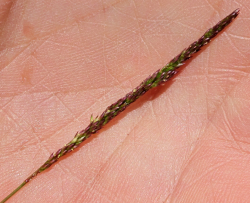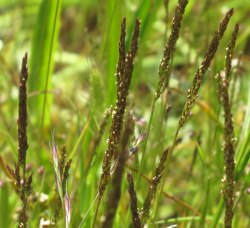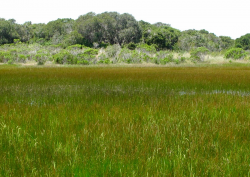
none

Spicate inflorescence of Agrostis lacuna-vernalis. Photo taken at Fort Ord National Monument © 2011 Dylan Neubauer.

Agrostis lacuna-vernalis. Photo taken at Fort Ord National Monument © 2011 Dylan Neubauer.

Habitat of Agrostis lacuna-vernalis at edge of vernal pool. Photo taken at Fort Ord National Monument © 2011 Dylan Neubauer.



This fact sheet was prepared by Dylan M. Neubauer under award NA04N0S4200074 from the National Oceanic and Atmospheric Administration (NOAA), U.S. Department of Commerce (DOC). The statements, findings, conclusions, and recommendations are those of the authors and do not necessarily reflect the views of the NOAA or the DOC.
© Copyright 2006, Elkhorn Slough Coastal Training Program
Last updated: Mar 24, 2016 19:03
Common Names - vernal pool bent grass
Family - Poaceae (Grass Family)
State Status - none
Federal Status - none
Habitat
Within or on the margins of vernal pools in more or less intact mima mound grassland; 115–145 m.
Key Characteristics
Annual herb, 1.5–30 cm tall; lower leaf blades flat, folded, or somewhat inrolled, 1.4–11 cm long, 0.3–1.5 mm wide, ligule 1.2–1.7 mm; inflorescence narrow, spicate, 1–7.5 cm long, primary branches appressed, 0.6–1.4 cm long; spikelets with callus glabrous; lemmas lacking awns; palea 0.7–1.1 mm, 1/3–2/3 lemma, anthers 0.4–0.7 mm (Peterson et al. 2011; Peterson and Harvey 2014).
Differs from Agrostis blasdalei by its annual habit, shorter glume and lemmas, and longer paleas. Differs from A. densiflora by its annual habit, more slender leaf blades, shorter lemmas, and its glabrous callus (Peterson et al. 2011).
Flowering Period
April–May
Reference Population
Fort Ord National Monument (Monterey County)
Global Distribution
Only known from Fort Ord National Monument (Monterey County).
History
This inconspicuous annual was only discovered in 2006 by botanist Ellen Holmes during a CNPS field trip to Butterfly Valley at Fort Ord National Monument in Monterey County. During lunch she glanced down and saw a grass she didn’t recognize. She asked botanist Randall Morgan if he recognized it, but he did not. Morgan grew several plants and pressings made from these were sent to Paul Peterson and Robert Soreng at the Smithsonian in 2010. In late fall of that year, the experts determined that this was a new species, which was described in 2011 (Holmes, personal communication; Styer, personal communication; Peterson et al. 2011). The extremely rare species was given a California Rare Plant Rank of 1B.1 in 2012.
Taxonomy and Nomenclature
Agrostis lacuna-vernalis was not included in 2012 The Jepson Manual, Second Edition, but was included in Revision 2 (Peterson and Harvey 2014) in the Jepson eFlora. Detailed DNA work has yet to be done on the genus Agrostis, and treatments differ as to the circumscription of various taxa.
Conservation
Due to its extreme rarity, the species was given a California Rare Plant Rank of 1B.1 in 2012. Between 1,000 and 10,000 individuals are present in the preferred habitat, which occupies only 2.5 square km in three separate populations.
Though protected on federal land, threats include competition from non-native species, unauthorized off-road vehicle use, and any adverse impacts that may occur to this wetland species as a result of climate change such as prolonged or frequent drought (Delgado, pers. comm.)
References
California Natural Diversity Database (CNDDB). 2016. RareFind 5 [Internet]. California Department of Fish and Wildlife [accessed 5 January 2016].
California Native Plant Society (CNPS), Rare Plant Program. 2016. Agrostis lacuna-vernalis. Inventory of Rare and Endangered Plants (online edition, v8-02). California Native Plant Society, Sacramento, CA. Website http://www.rareplants.cnps.org/detail/3732.html [accessed 14 January 2016].
Delgado, B. Personal communication [28 March 2016].
Holmes, E. Personal communication [January 2015].
Peterson, P. M. and M. J. Harvey. 2014. Agrostis lacuna-vernalis, Revision 2, in Jepson Flora Project (eds.) Jepson eFlora, http://ucjeps.berkeley.edu/cgi-bin/get_IJM.pl?tid=98887 [accessed 14 January 2016].
Peterson, P. M., R. J. Soreng, D. Styer, D. Neubauer, and R. Morgan. 2011. Agrostis lacuna-vernalis (Pooideae: Poeae: Agrostidinae), a new species from California. Journal of the Botanical Research Institute of Texas 5(2):422.
Soreng, R. J., G. Davidse, P. M. Peterson, F. O. Zuloaga, E. J. Judziewicz, T. S. Filgueiras & O. Morrone. 2003 and onwards. On-line taxonomic novelties and updates, distributional additions and corrections, and editorial changes since the four published volumes of the Catalogue of New World Grasses (Poaceae) published in Contr. U.S. Natl. Herb. vols. 39, 41, 46, and 48. http://www.tropicos.org/Project/CNWG. In R. J. Soreng, G. Davidse, P. M. Peterson, F. O. Zuloaga, T. S. Filgueiras, E. J. Judziewicz & O. Morrone (eds.) Internet Cat. New World Grasses. Missouri Botanical Garden, St. Louis.
Styer, D. Personal communication [January & March 2016].
Reviewers
David Styer (March 2016); Bruce Delgado (March 2016)
